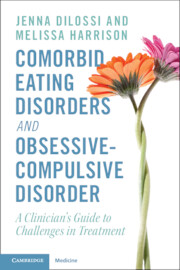 Comorbid Eating Disorders and Obsessive-Compulsive Disorder
Comorbid Eating Disorders and Obsessive-Compulsive Disorder Book contents
- Comorbid Eating Disorders and Obsessive-Compulsive Disorder
- Comorbid Eating Disorders and Obsessive-Compulsive Disorder
- Copyright page
- Contents
- Foreword
- Preface
- Acknowledgments
- Abbreviations
- Part I Overview of the Existing Literature
- Part II Clinical Pitfalls and Treatment Failures
- Part III Evidence-Informed Considerations for Assessment and Treatment
- Chapter 14 Thorough Assessment
- Chapter 15 Collaborative Conceptualization and Treatment Planning
- Chapter 16 Navigating Meal Planning
- Chapter 17 Navigating Self-Monitoring
- Chapter 18 Navigating the Scale & weighing
- Chapter 19 Navigating Body Image
- Part IV Special Topics and Future Considerations
- References
- Index
Chapter 18 - Navigating the Scale & weighing
from Part III - Evidence-Informed Considerations for Assessment and Treatment
Published online by Cambridge University Press: 14 December 2023
- Comorbid Eating Disorders and Obsessive-Compulsive Disorder
- Comorbid Eating Disorders and Obsessive-Compulsive Disorder
- Copyright page
- Contents
- Foreword
- Preface
- Acknowledgments
- Abbreviations
- Part I Overview of the Existing Literature
- Part II Clinical Pitfalls and Treatment Failures
- Part III Evidence-Informed Considerations for Assessment and Treatment
- Chapter 14 Thorough Assessment
- Chapter 15 Collaborative Conceptualization and Treatment Planning
- Chapter 16 Navigating Meal Planning
- Chapter 17 Navigating Self-Monitoring
- Chapter 18 Navigating the Scale & weighing
- Chapter 19 Navigating Body Image
- Part IV Special Topics and Future Considerations
- References
- Index
Summary
The treatments with the strongest evidence base for EDs use collaborative weighing at the beginning of each session, but this may be challenging for patients with comorbid OCD due to their increased tendency for rigidity, reassurance seeking, perfectionism, and a decreased tolerance for uncertainty. Personalized interventions should be devised to target the specific factors that maintain the patient’s disorder, such as addressing the core fears and how this impacts weight exposures (e.g., blind or viewed). Collaborative weighing is appropriate and needed for most patients. It is important to be mindful that certain aspects of providing weight information can become obsessive with this comorbidity, and engaging in hidden weighing can be useful in increasing tolerance of uncertainty related to changes in weight. Identifying and addressing compulsions and escape behaviors and encouraging the patient to abandon these behaviors and face the possibility of relapse can be beneficial for treatment in the long term.
- Type
- Chapter
- Information
- Comorbid Eating Disorders and Obsessive-Compulsive DisorderA Clinician's Guide to Challenges in Treatment, pp. 120 - 126Publisher: Cambridge University PressPrint publication year: 2023
